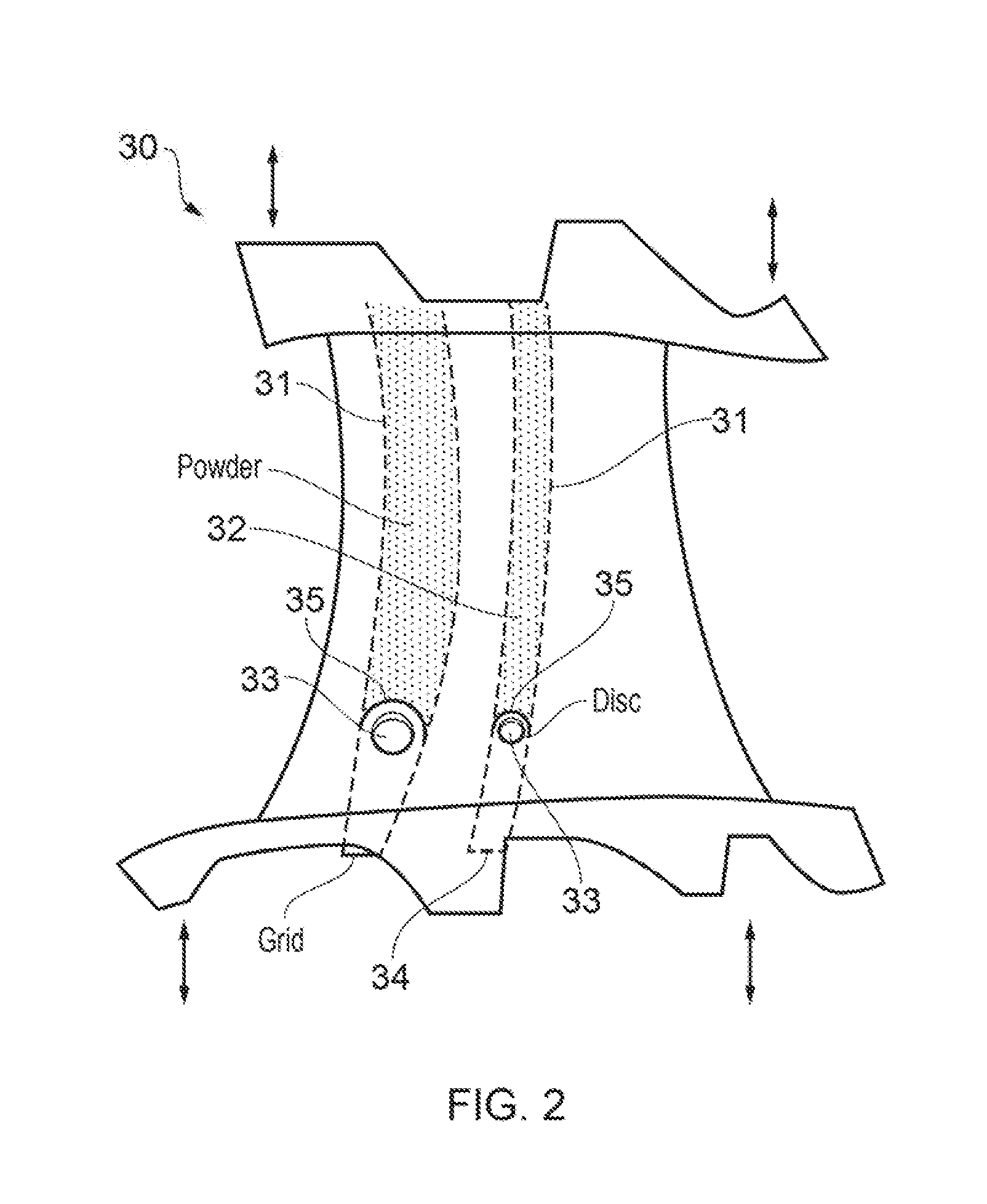Methods of manufacturing and cleaning
a manufacturing and cleaning technology, applied in the direction of manufacturing tools, machines/engines, stators, etc., can solve the problems of inability to remove excess powder from internal cavities, process complexity, and limited known techniques,
- Summary
- Abstract
- Description
- Claims
- Application Information
AI Technical Summary
Benefits of technology
Problems solved by technology
Method used
Image
Examples
first embodiment
[0050]In a method according to the present invention, the disc(s) 33 are inserted into the channels 31 and contained therein using containment grids 34 which are fixed on the inner / outer annulus faces of the component 30 so as to cover the exits from the channels 31. This method is illustrated schematically in FIG. 3.
[0051]To insert the disc into the channel 31, a depth equal to that of the diameter of the disc must first be cleared out, for example using traditional air blasting techniques (or chiselling with the titanium rod). The disc 33 can then be inserted into the channel 31 and contained using a grid / bar 34 that fastens onto the component 30 at one end of the channel 31. This grid / bar contains the disc 33 within the channel 31 allowing loosened powder to fall out of the channel by gravity. The powder 32 is loosened by vibrating the component 30, causing the disc 33 to repeatedly impact on the powder as described in more detail below. This process requires a degree of manual s...
second embodiment
[0052]In a method according to the present invention, the disc(s) 33 are provided to and retained in the channels 31 by a containment extension 35 which is attached onto the end of the channel 31 when the component 30 is placed on a vibrating shaker or other vibration source. This method is illustrated in FIG. 4.
[0053]The method using the containment extension 35 is an adaptation of the method of the first embodiment discussed above. This method has the benefit that the initial depth of powder 32 does not need to be removed from the channel 31, which makes the clearing process more automated and can provide for faster turnaround times. However, some manual set-up is still required. Further, by adding the extension bracket, higher frequency amplitudes may be required to enable the disc to travel the additional distance.
third embodiment
[0054]In a method according to the present invention, the discs 33 (or alternative impacting media) and the containment feature are sintered into the component during manufacturing. This method provides for a more automated approach to the cleaning.
[0055]To improve the automation of the clearing process, in the method according to the third embodiment, as illustrated in FIG. 5, the impacting media (e.g. discs 33, balls, pellets etc.) and the containment feature 36 are sintered in during the manufacture of the hollow component 30. The impacting media 33 is loosened prior to, or as part of, starting the shaking process to enable the media to gather momentum within the channel 31 and start the clearing process. For example a dropout 37 may be provided in the containment feature 36 which is formed of looser powder (e.g. similar to the powder formed in the cavity or channel 31). This dropout 37 may be shaken free at the start of the cleaning process. Alternatively, if sufficient energy i...
PUM
| Property | Measurement | Unit |
|---|---|---|
| rotational symmetry | aaaaa | aaaaa |
| surface area | aaaaa | aaaaa |
| size | aaaaa | aaaaa |
Abstract
Description
Claims
Application Information
 Login to View More
Login to View More - R&D
- Intellectual Property
- Life Sciences
- Materials
- Tech Scout
- Unparalleled Data Quality
- Higher Quality Content
- 60% Fewer Hallucinations
Browse by: Latest US Patents, China's latest patents, Technical Efficacy Thesaurus, Application Domain, Technology Topic, Popular Technical Reports.
© 2025 PatSnap. All rights reserved.Legal|Privacy policy|Modern Slavery Act Transparency Statement|Sitemap|About US| Contact US: help@patsnap.com



